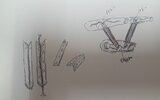hoggworks
Well-Known Member
Hey all!
Can anyone point me to suggestions/specs for a way to reinforce the Polar Lights 1/350 scale 1701-A? I’m assuming that using wood wouldn’t be the best idea, and I’ve primarily seen brass as a metal to prevent sag (for the nacelles and saucer section, primarily), but is that the best metal? Is aluminum a good/better idea? Something else? The model comes with three support points, one on the secondary hull and two in the saucer, but I want to have it supported by one rod through the secondary hull, with the armature extending as necessary on the inside of the model.
The kit isn’t super heavy, but I’ll be lighting it, so there will be a bit of extra weight there. Can anyone suggest what the minimum thickness that would make sense for a brass/aluminum/some other metal armature? It’s not crazy heavy, but it sure is relatively top-heavy, as the majority of the weight in the kit is in the saucer. Any directions a person could point me in would be much appreciated.
Thanks!
Can anyone point me to suggestions/specs for a way to reinforce the Polar Lights 1/350 scale 1701-A? I’m assuming that using wood wouldn’t be the best idea, and I’ve primarily seen brass as a metal to prevent sag (for the nacelles and saucer section, primarily), but is that the best metal? Is aluminum a good/better idea? Something else? The model comes with three support points, one on the secondary hull and two in the saucer, but I want to have it supported by one rod through the secondary hull, with the armature extending as necessary on the inside of the model.
The kit isn’t super heavy, but I’ll be lighting it, so there will be a bit of extra weight there. Can anyone suggest what the minimum thickness that would make sense for a brass/aluminum/some other metal armature? It’s not crazy heavy, but it sure is relatively top-heavy, as the majority of the weight in the kit is in the saucer. Any directions a person could point me in would be much appreciated.
Thanks!

